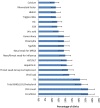Operational assessment of point-of-care diagnostics in rural primary healthcare clinics of KwaZulu-Natal, South Africa: a cross-sectional survey
- PMID: 29843711
- PMCID: PMC5975682
- DOI: 10.1186/s12913-018-3207-6
Operational assessment of point-of-care diagnostics in rural primary healthcare clinics of KwaZulu-Natal, South Africa: a cross-sectional survey
Abstract
Background: The World Health Organization (WHO) called for new clinical diagnostic for settings with limited access to laboratory services. Access to diagnostic testing may not be uniform in rural settings, which may result in poor access to essential healthcare services. The aim of this study is to determine the availability, current usage, and need for point-of-care (POC) diagnostic tests among rural primary healthcare (PHC) clinics in South Africa's KwaZulu-Natal (KZN) province.
Methods: We used the KZN's Department of Health (DoH) clinic classification to identify the 232 rural PHC clinics in KZN, South Africa. We then randomly sampled 100 of 232 rural PHC clinics. Selected health clinics were surveyed between April to August 2015 to obtain clinic-level data for health-worker volume and to determine the accessibility, availability, usage and need for POC tests. Professional healthcare workers responsible for POC testing at each clinic were interviewed to assess the awareness of POC testing. Data were survey weighted and analysed using Stata 13.
Results: Among 100 rural clinics, the average number of patients seen per week was 2865 ± 2231 (range 374-11,731). The average number of POC tests available and in use was 6.3 (CI: 6.2-6.5) out of a potential of 51 tests. The following POC tests were universally available in all rural clinics: urine total protein, urine leukocytes, urine nitrate, urine pregnancy, HIV antibody and blood glucose test. The average number of desired POC diagnostic tests reported by the clinical staff was estimated at 15 (CI: 13-17) per clinic. The most requested POC tests reported were serum creatinine (37%), CD4 count (37%), cholesterol (32%), tuberculosis (31%), and HIV viral load (23%).
Conclusion: Several POC tests are widely available and in use at rural PHC clinics in South Africa's KZN province. However, healthcare workers have requested additional POC tests to improve detection and management of priority disease conditions.
Trial registration: Clinical Trials.gov Identifier: NCT02692274.
Keywords: Diagnostic testing; Health services; KwaZulu-Natal; Point-of-care test; Primary healthcare clinics; Rural health; South Africa.
Conflict of interest statement
Ethics approval and consent to participate
This study was approved by the KZN Department of Health’s Ethics Committee (approval number: HRKM 40/15) and the University of KZN Biomedical Research Ethics Committee (approval number: BE484/14). Permission was obtained from the KZN district health managers prior to conducting the study. All study participants signed an informed consent prior to participating in the study.
Competing interests
The authors declare that they have no competing interests.
Publisher’s Note
Springer Nature remains neutral with regard to jurisdictional claims in published maps and institutional affiliations.
Figures
References
-
- Myer L, Wilkinson D, Lombard C, Zuma K, Rotchford K, Karim SA. Impact of on-site testing for maternal syphilis on treatment delays, treatment rates, and perinatal mortality in rural South Africa: a randomised controlled trial. Sex Transm Infect. 2003;79(3):208–213. doi: 10.1136/sti.79.3.208. - DOI - PMC - PubMed
-
- McIntyre D, Gilson L, Wadee H, Thiede M, Okarafor O. Commercialisation and extreme inequality in health: the policy challenges in South Africa. J Int Dev. 2006;18(3):435–446. doi: 10.1002/jid.1293. - DOI
Publication types
MeSH terms
Associated data
Grants and funding
LinkOut - more resources
Full Text Sources
Other Literature Sources
Medical
Research Materials
Miscellaneous



